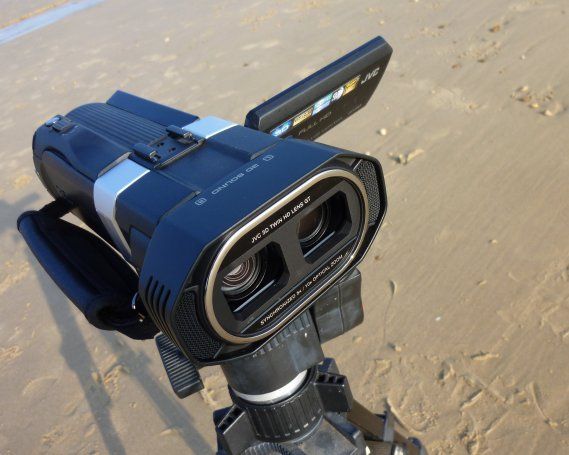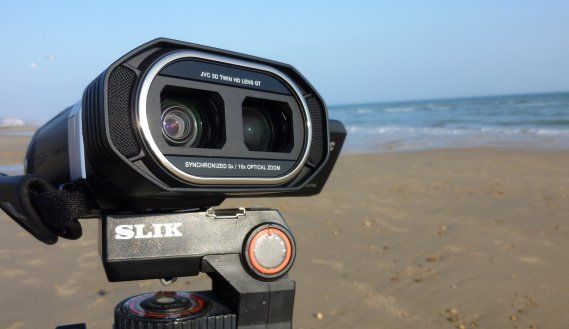Until now, Panasonic has been a lonely champion for homemade 3D, offering a range of camcorders compatible with its VW-CLT1 3D accessory lens. We looked at the brand’s HDC-SD900 recently and were suitably impressed, although like all the 3D capable models in Panasonic’s line-up the SD900 is first and foremost a 2D shooter.
Our quick take
The JVC Everio GS-TD1 redefines what we can expect of a 3D camcorder. This shooter may be a tad cumbersome, but compared to a pro-rig it’s a masterpiece of compact engineering. We loved the unparalleled creative control on offer, and 3D image quality is excellent. Overall, this is a remarkable piece of kit.
The Everio GS-TD1 is as special as it is specialised. It sets a new benchmark for 3D camcorders, delivering footage which can rival the clarity of Blu-ray (camera person not withstanding). If you’re eager to shoot and edit in 3D, then our advice is to audition it immediately.

JVC Everio GS-TD1 - 4.5 / 5
| FOR | AGAINST |
|---|---|
|
|
The JVC Everio GS-TD1 is an entirely different proposition: a genuine, full-on 3D camcorder. Its nearest relation is probably Panasonic’s pro-centric AG-3DA1, which the last time we looked sold for the best part of 18,000 euros. In that context, the TD1’s £1,600 price tag looks extremely reasonable.
The two mournful HD GT lenses of the TD1 may make this cam look like a relation to Wall-E, but each feeds its own 3.32-megapixel 1CMOS sensor. JVC’s new Falconbrid imaging system then integrates the incoming streams to create 3D images. The GS-TD1 can record in either side-by-side AVCHD format or Full HD MP4 MVC 1920 x 1080/50i, an iteration of the MultiView codec used for 3D Blu-ray. It can also take 3D still images in .MPO format.
The GS-TD1 has an internal 64GB flash memory which holds a fair amount of footage. If you prefer, you can shoot onto SD/SDHC/SDXC cards. JVC actually makes backing up from the internal hard drive refreshingly easy. A single menu command allows you to either copy all the files, or burn them to disc.
Lights camera action
Once you’re charged up for the first time, you’ll need to set the date, time and location. As the dual lens assembly is part of the camera (unlike Panasonic’s bolt on accessory), there’s no need to converge them each time you want to shoot. The lens cover needs to be manually opened and closed, via a lever on the right-hand side of the lens.
We particularly liked the fact that the side-mounted 3.5-inch touch-panel monitor is autostereoscopic; it uses the same parallax barrier screen technology as the Nintendo 3DS. Having a 3D display means you can play back, or compose, in 3D without having to wear special glasses.
With 920k pixel resolution, this touchscreen monitor is sharp enough to comfortably display a host of info while recording: 2D/3D mode, shutter speed, image size, media, battery, etc. You can use the display by either tapping or dragging; you tap the icons or files you want to open, or drag the thumbnails to sort through them.
There’s even provision for adjusting 3D depth while recording. Normally this is set to Auto, and calculates where the screen plane (zero parallax) should be for the most comfortable viewing. Alternatively, you can tweak playback using the Automatic Parallax Adjustment button.
Unlike Panasonic’s 3D fleet, there are no restrictions on zooming and 3D effectiveness. The TD1 can dimensionalise across a much wider zone (typically 5-50m in telephoto). This means that when you’re out and about it pays to use a tripod.
Picture this
The 3D performance of the TD1 is outstanding. The best image quality comes when shooting in the 1080p MVC modes. There are two flavours available: THR with an average bitrate of 34Mbps, and TSR with an average bitrate of 22Mbps. This translates to 4 and 6 hours recording respectively.
Unfortunately, while 3D images produced under MVC look super crisp, you can’t do much with them aside from play them out directly from the camcorder into a 3D display. If you want to edit and distribute your 3D masterpieces it makes more sense to shoot in side-by-side AVCHD. Here you can opt for either TXP mode (24Mbps for 5 hours 50 mins) or TSP (12Mbps for 11 hours 40 mins). Although this is half the resolution of MVC footage it never really feels like a massive compromise.
Unlike the 3D fare shot on any of the Panasonic models, there’s no image-compromising border. The 5x optical zoom also remains available when shooting in 3D, along with the snappily entitled Optical Axis Automatic Stabilization System which corrects any displacement between L and R images. We can't embed the 3D sample, but if you want to view it on YouTube, you can find it here: 3D YouTube sample.
Naturally, the GS-TD1 can also shoot in 2D, utilising the stream from the left lens. There are four AVCHD 2D modes with bitrates that range from 24Mbps to just 5Mbps. Picture quality is very good. At times we felt test footage shot in IA mode looked a little too bright, but there is a full raft of manual controls to compensate. Tellingly, the backlit CMOS sensors behind the two lenses are said to be twice as sensitive to light as previous CMOS sensors from the brand.
Audio is courtesy of the brand’s Biphonic “surround” mic, which works reasonably well.
To recap
The JVC Everio GS-TD1 redefines what we can expect of a 3D camcorder. This shooter may be a tad cumbersome, but compared to a pro-rig it’s a masterpiece of compact engineering. We loved the unparalleled creative control on offer, and 3D image quality is excellent. Overall, this is a remarkable piece of kit

